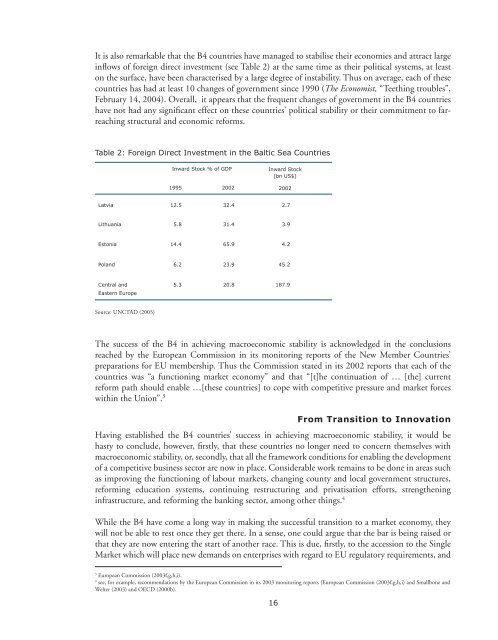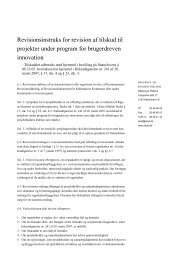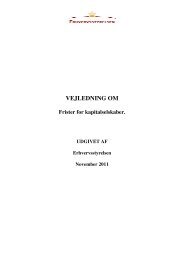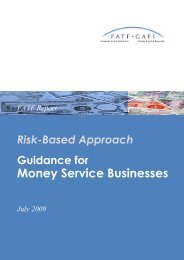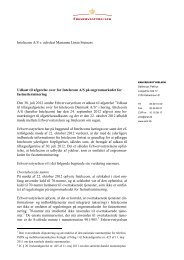It is also remarkable that <strong>the</strong> B4 countries have managed to stabilise <strong>the</strong>ir economies <strong>and</strong> attract large<strong>in</strong>flows of foreign direct <strong>in</strong>vestment (see Table 2) at <strong>the</strong> same time as <strong>the</strong>ir political systems, at leaston <strong>the</strong> surface, have been characterised by a large degree of <strong>in</strong>stability. Thus on average, each of <strong>the</strong>secountries has had at least 10 changes of government s<strong>in</strong>ce 1990 (The Economist, “Teeth<strong>in</strong>g troubles”,February 14, 2004). Overall, it appears that <strong>the</strong> frequent changes of government <strong>in</strong> <strong>the</strong> B4 countrieshave not had any significant effect on <strong>the</strong>se countries’ political stability or <strong>the</strong>ir commitment to farreach<strong>in</strong>gstructural <strong>and</strong> economic reforms.Table 2: Foreign Direct Investment <strong>in</strong> <strong>the</strong> Baltic Sea CountriesInward Stock % of GDP1995 2002Inward Stock(bn US$)2002Latvia 12.5 32.4 2.7Lithuania 5.8 31.4 3.9Estonia 14.4 65.9 4.2Pol<strong>and</strong> 6.2 23.9 45.2Central <strong>and</strong>Eastern Europe5.3 20.8 187.9Source: UNCTAD (2003)The success of <strong>the</strong> B4 <strong>in</strong> achiev<strong>in</strong>g macroeconomic stability is acknowledged <strong>in</strong> <strong>the</strong> conclusionsreached by <strong>the</strong> European Commission <strong>in</strong> its monitor<strong>in</strong>g reports of <strong>the</strong> New Member Countries’preparations for EU membership. Thus <strong>the</strong> Commission stated <strong>in</strong> its 2002 reports that each of <strong>the</strong>countries was “a function<strong>in</strong>g market economy” <strong>and</strong> that “[t]he cont<strong>in</strong>uation of … [<strong>the</strong>] currentreform path should enable …[<strong>the</strong>se countries] to cope with competitive pressure <strong>and</strong> market forceswith<strong>in</strong> <strong>the</strong> Union”. 3From Transition to InnovationHav<strong>in</strong>g established <strong>the</strong> B4 countries’ success <strong>in</strong> achiev<strong>in</strong>g macroeconomic stability, it would behasty to conclude, however, firstly, that <strong>the</strong>se countries no longer need to concern <strong>the</strong>mselves withmacroeconomic stability, or, secondly, that all <strong>the</strong> framework conditions for enabl<strong>in</strong>g <strong>the</strong> developmentof a competitive bus<strong>in</strong>ess sector are now <strong>in</strong> place. Considerable work rema<strong>in</strong>s to be done <strong>in</strong> areas suchas improv<strong>in</strong>g <strong>the</strong> function<strong>in</strong>g of labour markets, chang<strong>in</strong>g county <strong>and</strong> local government structures,reform<strong>in</strong>g education systems, cont<strong>in</strong>u<strong>in</strong>g restructur<strong>in</strong>g <strong>and</strong> privatisation efforts, streng<strong>the</strong>n<strong>in</strong>g<strong>in</strong>frastructure, <strong>and</strong> reform<strong>in</strong>g <strong>the</strong> bank<strong>in</strong>g sector, among o<strong>the</strong>r th<strong>in</strong>gs. 4While <strong>the</strong> B4 have come a long way <strong>in</strong> mak<strong>in</strong>g <strong>the</strong> successful transition to a market economy, <strong>the</strong>ywill not be able to rest once <strong>the</strong>y get <strong>the</strong>re. In a sense, one could argue that <strong>the</strong> bar is be<strong>in</strong>g raised orthat <strong>the</strong>y are now enter<strong>in</strong>g <strong>the</strong> start of ano<strong>the</strong>r race. This is due, firstly, to <strong>the</strong> accession to <strong>the</strong> S<strong>in</strong>gle<strong>Market</strong> which will place new dem<strong>and</strong>s on enterprises with regard to EU regulatory requirements, <strong>and</strong>3European Commission (2003f,g,h,i).4see, for example, recommendations by <strong>the</strong> European Commission <strong>in</strong> its 2003 monitor<strong>in</strong>g reports (European Commission (2003f,g,h,i) <strong>and</strong> Smallbone <strong>and</strong>Welter (2003) <strong>and</strong> OECD (2000b).16
<strong>in</strong>creased competitive pressure as B4 enterprises must compete with <strong>the</strong>ir o<strong>the</strong>r EU counterparts <strong>in</strong><strong>the</strong> S<strong>in</strong>gle <strong>Market</strong>. 5 Secondly, <strong>and</strong> perhaps more importantly, <strong>the</strong> current structural changes (oftendescribed as <strong>the</strong> rise of <strong>the</strong> “knowledge-based economy” – see Box 1), <strong>and</strong> <strong>the</strong> implications of <strong>the</strong>sechanges, are putt<strong>in</strong>g new dem<strong>and</strong>s on governments, <strong>in</strong>stitutions, <strong>in</strong>dividuals <strong>and</strong> companies to adjust,act <strong>and</strong> cooperate <strong>in</strong> order to ensure future competitiveness <strong>and</strong> growth, both at firm <strong>and</strong> countrylevels.As countries develop economically – <strong>and</strong> given equal access to global markets, <strong>the</strong> rapid pace oftechnological change, <strong>the</strong> trend towards shorter product life cycles <strong>and</strong>, more generally, <strong>the</strong> rapidlygrow<strong>in</strong>g importance of knowledge –, <strong>the</strong> ability to <strong>in</strong>novate becomes an <strong>in</strong>creas<strong>in</strong>gly criticaldeterm<strong>in</strong>ant of <strong>in</strong>ternational competitiveness. In advanced nations today, competitive advantage “…must come from <strong>the</strong> ability to create <strong>and</strong> <strong>the</strong>n commercialize new products <strong>and</strong> processes, shift<strong>in</strong>g <strong>the</strong>technology frontier as fast as <strong>the</strong>ir rivals can catch up” (Porter <strong>and</strong> Stern (2003), p.1). Gradually, <strong>the</strong>ability to <strong>in</strong>novate has thus become accepted as a crucial prerequisite of enterprise development <strong>and</strong>entrepreneurship, <strong>and</strong> concepts such as ‘<strong>in</strong>novation policy’ <strong>and</strong> ‘<strong>in</strong>novation systems’ are <strong>in</strong>creas<strong>in</strong>glyattract<strong>in</strong>g <strong>the</strong> attention of policy makers <strong>in</strong> most EU countries (see Box 2).The low growth <strong>and</strong> economic stagnation experienced by a number of EU Member States <strong>in</strong> recentyears, at a time of general macroeconomic stability, illustrate that countries cannot simply rely onfavourable macroeconomic framework conditions to ensure competitiveness <strong>and</strong> growth. Instead,countries must seek to comb<strong>in</strong>e macroeconomic stability with design<strong>in</strong>g <strong>and</strong> implement<strong>in</strong>g effectivemicroeconomic policies, <strong>and</strong> thus <strong>in</strong> effect putt<strong>in</strong>g <strong>in</strong> place enabl<strong>in</strong>g ‘framework conditions for<strong>in</strong>novation’:The scope of what is viewed as framework conditions may be def<strong>in</strong>ed <strong>in</strong> different ways. In a broad sense,<strong>the</strong>y may <strong>in</strong>clude well-function<strong>in</strong>g product markets (goods <strong>and</strong> services) as well as factor markets (labourmarket, <strong>the</strong> f<strong>in</strong>ancial markets <strong>in</strong>clud<strong>in</strong>g venture capital), education <strong>and</strong> science system, <strong>and</strong> physical,<strong>in</strong>stitutional <strong>and</strong> juridical <strong>in</strong>frastructure, <strong>in</strong>clud<strong>in</strong>g a governance system that is able to susta<strong>in</strong> effective<strong>and</strong> consistent play<strong>in</strong>g rules for <strong>in</strong>novation. Hard-def<strong>in</strong>ed aspects such as social capital <strong>and</strong> attitudesthat underp<strong>in</strong> trust <strong>in</strong> transactions, entrepreneurship, risk-tak<strong>in</strong>g, etc., are also of great importance.(Andersson et. al. (2004a), p.32)For <strong>the</strong> B4 countries this means that, <strong>in</strong> order to compete successfully <strong>in</strong> <strong>the</strong> global market, <strong>and</strong> tocont<strong>in</strong>ue to grow at a pace that will allow <strong>the</strong>m to br<strong>in</strong>g <strong>the</strong>ir GDP per capita levels closer to <strong>the</strong> EUaverage (see Table 1), <strong>the</strong>y must streng<strong>the</strong>n <strong>the</strong> ability <strong>and</strong> will<strong>in</strong>gness of <strong>the</strong>ir enterprises to <strong>in</strong>novate,to be <strong>in</strong>ternationally competitive <strong>and</strong> to grow.Some analysts have expressed concerns that, at least up until recently, policymakers <strong>in</strong> <strong>the</strong> B4 countrieshave focused largely, or exclusively, on macroeconomic conditions, <strong>and</strong> have not been pay<strong>in</strong>g enoughattention to streng<strong>the</strong>n<strong>in</strong>g <strong>the</strong>ir countries’ <strong>and</strong> firms’ <strong>in</strong>novative capacities. Thus, a recent reportcommissioned by <strong>the</strong> European Commission observed that:After 10 years of limit<strong>in</strong>g itself to macroeconomic policy <strong>and</strong> transition-related <strong>in</strong>stitutionaltransformation, policy <strong>in</strong> Latvia <strong>and</strong> Lithuania faces <strong>the</strong> challenge of how to effectively use countries’human potential.(European Commission (2003c), p.22)5Many B4 companies are already compet<strong>in</strong>g with EU companies today (both <strong>in</strong> <strong>the</strong>ir home markets <strong>and</strong> abroad). However, <strong>in</strong> <strong>the</strong> com<strong>in</strong>g years, thiscompetition is likely to gradually extend to more <strong>and</strong> more bus<strong>in</strong>ess sectors <strong>and</strong> <strong>in</strong>tensify <strong>in</strong> certa<strong>in</strong> bus<strong>in</strong>ess segments.17
- Page 1 and 2: Sylvia Schwaag SergerEmily HanssonC
- Page 4 and 5: About the International Organisatio
- Page 7: PREFACEAccession to the Single Mark
- Page 10 and 11: enterprise development. There are n
- Page 12 and 13: BOXESBox 1: The ‘Knowledge-Based
- Page 15 and 16: INTRODUCTIONAfter more than 10 year
- Page 17: CHAPTER 1: FROM STABILISATION TO IN
- Page 22 and 23: Box 2: On Innovation and Innovation
- Page 24 and 25: Table 5: GDP Growth 1995-2003 in Se
- Page 26 and 27: Table 7: Relative Strengths and Wea
- Page 28 and 29: Box 3: The Indicator ProblemExistin
- Page 31 and 32: CHAPTER 2:BALTIC SMEs - AGENTS OF F
- Page 33 and 34: Table 9: Average Annual Growth of S
- Page 35 and 36: Box 4: Overview of Selected Multina
- Page 37 and 38: The Role of SMEs in Transitional Ec
- Page 39 and 40: e to the potential advantage of the
- Page 41 and 42: A common measurement of business ac
- Page 43 and 44: Figure 8: Labour Productivity per P
- Page 45 and 46: Figure 10: Employment in Med/Hi-tec
- Page 47 and 48: Summing up, there are fewer economi
- Page 49 and 50: Overall, SMEs tend to lack the fina
- Page 51 and 52: Figure 12: Enterprises with Innovat
- Page 53 and 54: Figure 14: Proportion of Enterprise
- Page 55 and 56: Table 14: Barriers to Innovation fo
- Page 57 and 58: Some interesting examples of cluste
- Page 59 and 60: CHAPTER 3:POLICIES PROMOTING SMEs A
- Page 61 and 62: National governments themselves wil
- Page 63 and 64: Institutional StructureIn all of th
- Page 65 and 66: EU countries (innovation relay cent
- Page 67 and 68: LITHUANIAAgency/OrganisationLithuan
- Page 69 and 70:
From the private sector, the chambe
- Page 71 and 72:
On the whole, the B4 have relativel
- Page 73 and 74:
LITHUANIAProgramme/Policy DocumentI
- Page 75 and 76:
Table 19: B4 National Rankings of A
- Page 77 and 78:
Box 11: Structural Funds to the Can
- Page 79 and 80:
Box 12: On SMEs and FinancingIt doe
- Page 81 and 82:
examples of evaluations of national
- Page 83 and 84:
CHAPTER 4:CHALLENGES AND RECOMMENDA
- Page 85 and 86:
General challengesBased on our own
- Page 87 and 88:
the above-mentioned channels. 27 On
- Page 89 and 90:
the EU average and particularly wit
- Page 91 and 92:
RecommendationsBased on the challen
- Page 93 and 94:
CHAPTER 5:A VISION OF A NORDIC-BALT
- Page 95 and 96:
addition, they are the most advance
- Page 97 and 98:
countries. One such sign is the rap
- Page 99 and 100:
CONCLUSIONSEU accession will not re
- Page 101 and 102:
REFERENCESAlfonso, Antonio, Ludger
- Page 103 and 104:
European Commission (2003f), Compre
- Page 105 and 106:
Eurostat (2004a), SMEs in the Candi
- Page 107 and 108:
Statistical Office of Estonia (2004
- Page 109 and 110:
APPENDIX I:Agenda for Working Group
- Page 111 and 112:
DAY 2:POLICY SOLUTIONS9:30-10:30 In
- Page 113 and 114:
APPENDIX II:Participants in the IKE
- Page 115 and 116:
APPENDIX III:Conclusions from the I
- Page 117 and 118:
APPENDIX IV:Summary of the Panel se
- Page 119 and 120:
Regarding the role of policymaking,
- Page 121 and 122:
APPENDIX V:Description of Field Stu
- Page 123 and 124:
Mr. Miroslaw MarekMr. Talis Millers
- Page 126:
IKED - International Organisation f


